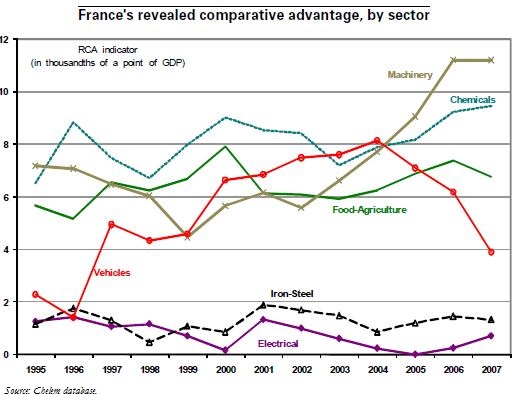Trésor-Economics No. 68 - French and German export specialization: similarity or divergence?
Various studies of the trade performance of France and Germany find similarity in the two countries' sectoral export specializations. An examination of highly disaggregated data using the CEPII revealed comparative advantage indicator yields a more nuanced view. When examining aggregated data, France and Germany are found to have similar areas of revealed comparative advantage but those areas are concentrated in fewer sectors in Germany than in France. The similarity in revealed comparative advantage is far less clear-cut when the data are examined at a more detailed level.
According to the aggregated sector data, both countries have revealed comparative advantage in Vehicles, Chemicals, Machinery (including aeronautics), and to a lesser degree in the Electrical sector. France also has comparative advantage in Food-Agriculture and to a lesser degree in Iron-Steel. But Germany's revealed comparative advantage in the Machinery and Vehicles sectors is far higher than France's.
Over the 1995-2007 period, Germany's structure of comparative advantage was more stable than France's, as the Vehicles and Machinery sectors remained distinctly in the lead in Germany. On the other hand, France's comparative advantage was gradually concentrated in the Machinery sector, on the strength of aeronautics, while the Vehicles sector lost considerable ground at the end of the period. The concentration of comparative advantage in aeronautics leaves French exports particularly exposed to changes in the euro.
Germany's concentration of areas of revealed comparative advantage by product appears even more clearly at a more detailed disaggregated level: France's highest comparative advantage is in products in the Machinery, Electrical, Food-Agriculture, and Chemicals sectors, and luxury products, while Germany's comparative advantage is concentrated in products in the Vehicles and Machinery sectors. France appears to have more diversified areas of comparative advantage, whereas Germany's are concentrated in top-of-the-range vehicles and capital goods.
Since 2000, both countries have achieved their largest gains in comparative advantage in high-technology products (the Electrical, Machinery and Chemicals sectors for France, and the Machinery, Electrical and Vehicles sectors for Germany). There are greater divergences in the two countries' losses in comparative advantage. For France, these areas are concentrated in numerous high-technology products (for the essential part, in the Electrical and Vehicles sectors), while Germany's losses are in low-value-added, low-technology products.
